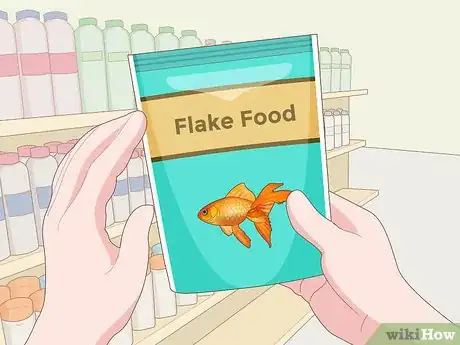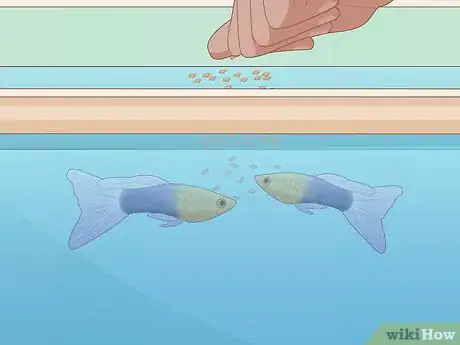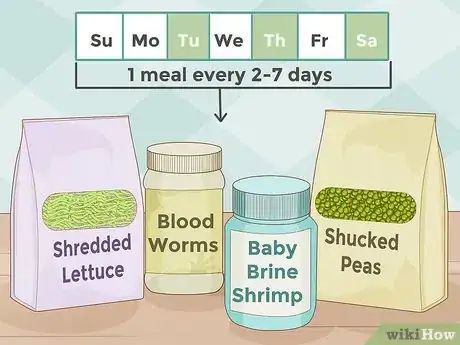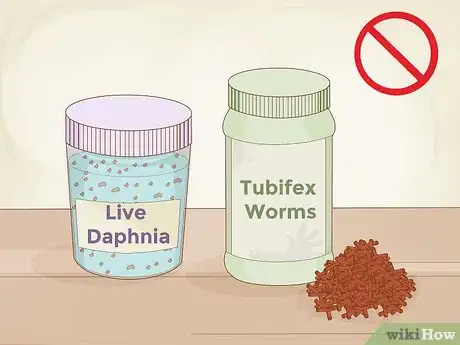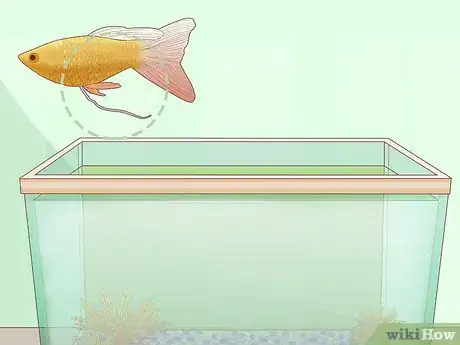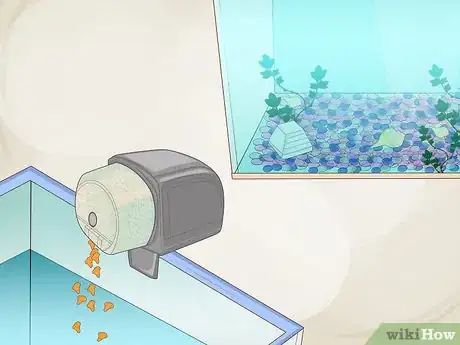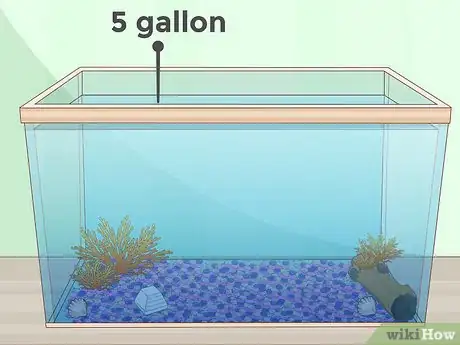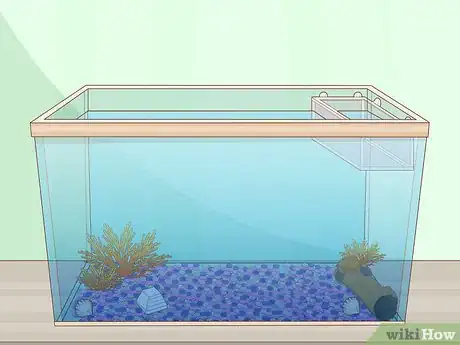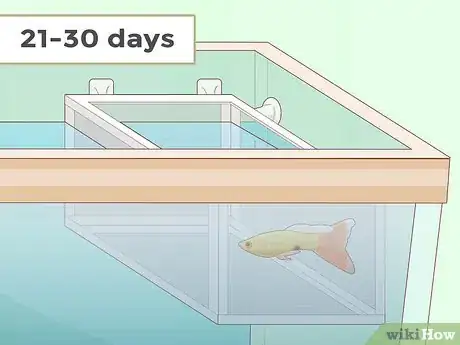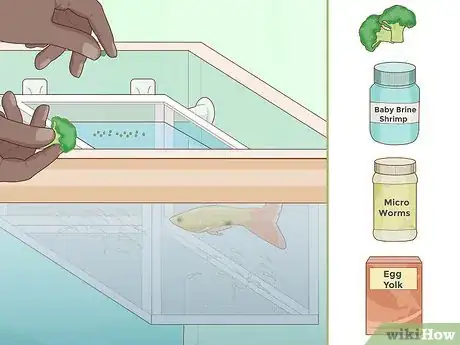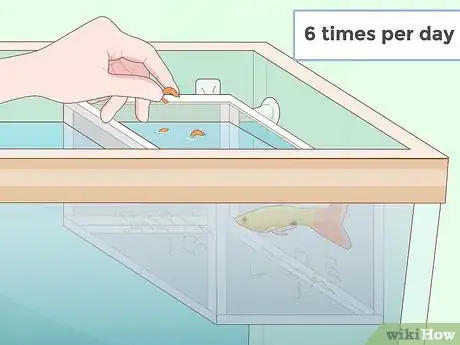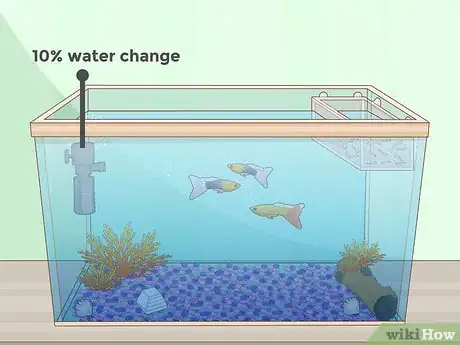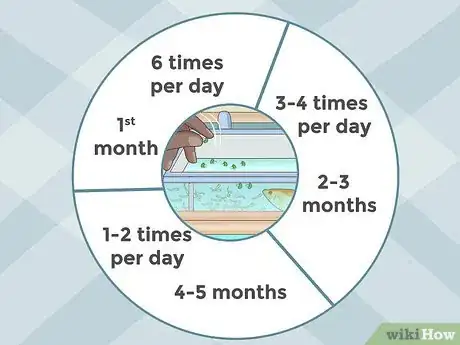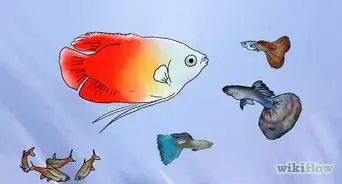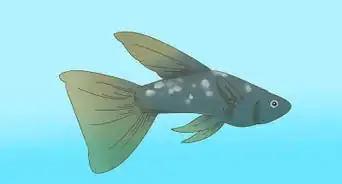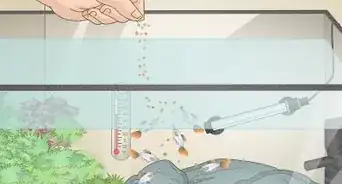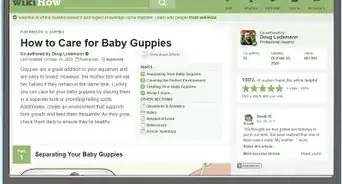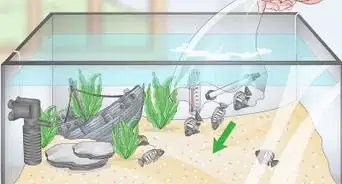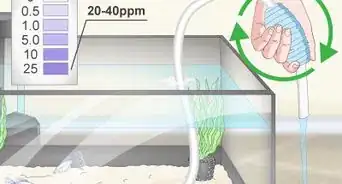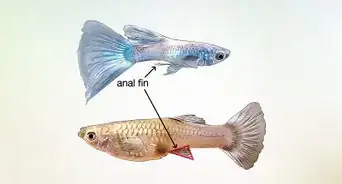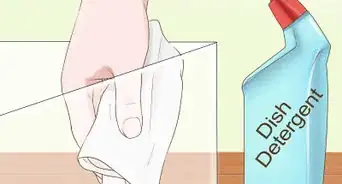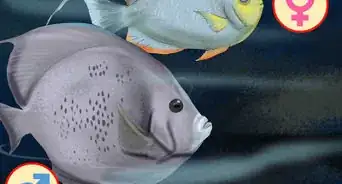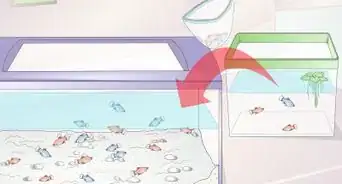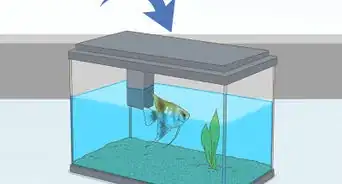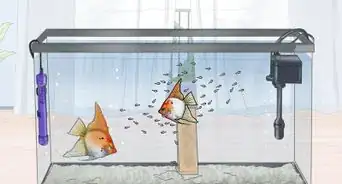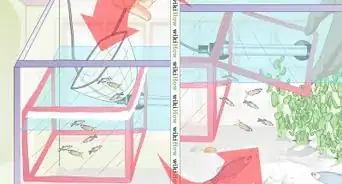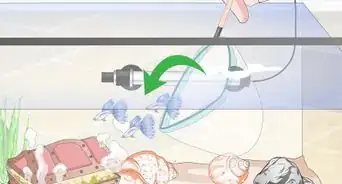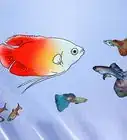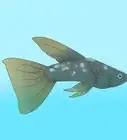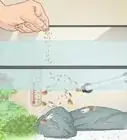wikiHow is a “wiki,” similar to Wikipedia, which means that many of our articles are co-written by multiple authors. To create this article, 29 people, some anonymous, worked to edit and improve it over time.
wikiHow marks an article as reader-approved once it receives enough positive feedback. This article received 13 testimonials and 94% of readers who voted found it helpful, earning it our reader-approved status.
This article has been viewed 270,146 times.
Learn more...
Guppies are active and often colorful, making them popular aquarium pets. Feeding them is an uncomplicated task, but it's good to learn about your guppies' needs to avoid overfeeding. Guppy young require a special diet, although one easily available at a fish store, and even adults will be healthier if you supplement their fish flakes with more nutritious food.
Steps
Feeding Adult Guppies
-
1Purchase flake food made for tropical fish. You can purchase flake food at a pet store or fish shop to use as a basic, daily food supply. While guppies will eat any type of flake food, high quality brands that contain both protein and vegetable matter are best. Flake food intended for tropical fish often include natural color enhancers that will make your guppies appear brighter and more colorful. Do not purchase fish food in pellet form, as this will be difficult or impossible for guppies to eat with their small mouths.
- If you purchase more flake food than you will use in a month, freeze the excess to preserve nutrients. Thaw another month's supply a couple days before you need a refill.
-
2Feed the guppies a pinch of flake food once or twice a day, preferably in the morning and at night, leaving a twelve-hour difference between the two. Drop a tiny pinch of flakes into the water and watch the guppies eat. They should be finished with the meal in about 30–60 seconds, and certainly no longer than a few minutes.[1] You may decide to feed them once or twice a day, as long as you do so in appropriate amounts. It is easy to feed guppies too much food, and difficult to feed them too little.
- Guppies will continue to eat or search for food even when they do not need it. Do not feed your fish an additional meal because the fish appear hungry. In fact, guppies that actively seek food will prevent food debris from building up and dirtying your water.
Advertisement -
3Replace the occasional flake food meal with more nutritious treats. While guppies will survive on flake food alone, live or frozen plants and animals contain extra nutrients that are ideal for supplementing a flake food diet. Replace one flake food meal every 2–7 days with no more treats than the guppies will finish within 60 seconds. Any of the following are appropriate treats, and most can be found at fish shops:
- Baby brine shrimp contain mostly protein, and are ideal supplements if your flake food is high in vegetable content and low in protein (40% or less). They are available in live, frozen, or flake form.
- Blood worms or mosquito larvae are good treats that you can catch yourself by running a net through standing water. Acquire small quantities of larvae at a time to prevent them hatching into mosquitoes. Earthworms are also appropriate, but must be shredded and rinsed before feeding to the guppies.
- Feed your guppies shucked peas, shredded lettuce, or finely chopped cucumber, especially if their flake food is high in protein but low in vegetable content.
-
4Avoid tubifex worms and live daphnia. Many other types of fish food exist, and fish store employees or other guppy owners may recommend other types of treat. However, you should try to avoid tubifex worms and daphnia, even if recommended to you. While guppies will eat them enthusiastically, tubifex worms sometimes contain lethal bacteria. Live daphnia will only cause harm in large quantities by removing oxygen from the tank, but they are typically more expensive and difficult to raise than other live foods.
-
5Watch for signs of overfeeding. Because guppies have such small stomachs but still eat large quantities of food if available, overfeeding is common. If you notice any of the following signs, reduce the number of meals you feed them or the frequency of their treats. Some guppy owners only feed their fish 6 days a week, letting them go hungry on the seventh for their health.
- Tubes of waste dangling behind the fish are a sign of a blocked intestine from overeating.
- Adult male guppies develop a "potbelly" or bulging chest if they have too much fat in their diet. Reduce the amount of food and replace fatty treats such as blood worms or beef heart with crumbs of fat-free ham.
- If your tank water gets cloudy and dirty frequently, excess food or waste may be the cause. As a general rule, you should change 20–30% of the water in your tank about once every 1–2 weeks, or more frequently for crowded tanks.
-
6Consider feeding methods for vacations longer than one week. Healthy, adult guppies can last a week without food before experiencing any lasting effects, so if you are only going to be gone a few days, consider simply not feeding them. For a longer trip, one of the following methods is recommended:[2]
- Use an automatic feed dispenser to dispense food at regular intervals. Make sure you supply enough food for the whole time you'll be away, and set the dispenser to release food once or twice a day.
- Test a feeder block or gel feeder before leaving. These blocks of dry or gel-covered food are left in the tank and eaten slowly. However, the dry blocks may cause dangerous chemical changes, while the gel variety sometimes go ignored. Test either variety for a few days before leaving so you can be sure there are no problems.
- Have a friend or neighbor feed them their usual flake food once every two or three days. Because inexperienced feeders often give too much food, it's best to place each pinch of food in a pillbox or other container with the day of the week carefully marked on it. Make it clear to the caretaker that overfeeding could kill your guppies.
Caring for and Feeding Young Guppies
-
1Prepare a separate breeding tank. Young guppies, also known as "fry", require special feeding separate from the adults, and should be separated for their safety as well.[3] Prepare a 5-gallon (20 L) tank with care, making sure it has everything necessary for the guppies' survival. As with any aquarium, running a fishless cycle is an excellent way to prepare the tank before you introduce any fish.
-
2Divide your breeding tank into two sections using a breeding net. Purchase a breeding net or mesh from a fish store that divides the tank into two sections. The newly hatched guppies will be able to swim through the holes of the net and escape the mother fish, which may try to eat them.
- If you don't want to purchase a net or are not sure if the net you have has the right sized holes, you may protect the fry by planting several aquarium plants for them to hide in.
-
3Move pregnant females to the breeding tank until they give birth. Females have a dark spot on their abdomen, also called a gravid spot, which becomes much darker once her internal eggs have been fertilized. The eggs will grow inside her for 21–30 days, and her abdomen will become larger and darker as this happens.[4] Transfer the female back to the main tank as soon as you notice she has given birth, so she does not compete with the fry for food or attempt to eat her young.
- If you are breeding guppies to sell or to produce specific traits, move the male and female you wish to breed into the tank before the female is pregnant. Return the male to the main tank once you notice the darker gravid spot. Note that female guppies can store sperm for months, so a fish you purchased as an adult may be fertilizing her eggs with a male not present in your tank for the first several litters.
-
4Prepare special food for your fry. Guppy fry have tiny mouths and high protein requirements, so they must be fed separately from the adults. Have their special food ready to go before the fry are born, and include both protein sources and vegetable matter. High quality protein can be supplied in the form of baby brine shrimp (not adult), microworms, finely chopped beef heart, and/or a mash of egg yolk and water.[5] Vegetable matter can be used in smaller quantities, and can take the form of infusoria (microscopic organisms that color pond water green), fresh and finely chopped dark green lettuce, or small pieces of boiled spinach.[6]
- Do not to feed them adult brine shrimp until they have grown into juveniles; if the shrimp remains untouched it is too big for the fry to eat.
-
5Feed the fry several times a day. Growing fry have greater energy needs than adult guppies as well as smaller stomachs, so feed them tiny amounts of food about 6 times daily. If the water grows dirty or cloudy despite frequent water changes, reduce the amount of food and make sure it is small enough for them to eat.
-
6Change small amounts of water frequently. Once your fry have been born, you may wish to change 10% or less of the water every couple days, instead of doing a larger and more stressful water change every week or two.[7] Young fish are especially vulnerable to water changes, and the high frequency of feeding can cause waste to build up in the tank quickly.
-
7Reduce the frequency of their feedings gradually. After about 2 months, the fry should be considerably larger and will only need to be fed 3–4 times a day. After about 4–5 months, they can be switched to an adult diet and fed 1–2 times a day. You may choose to alter the diet slowly to increase the odds of the fry accepting flakes, gradually replacing other parts of the diet with flake food. Different varieties and individuals will grow at different rates, however, and you should not move the fry into a tank with adult fish until they are close to the same size.
- You may be able to switch to larger food such as adult brine shrimp earlier if your guppies are growing at a good rate. Keep feeding the juveniles high quality food, however, and watch them to make sure they eat the new food.
Community Q&A
-
QuestionDo guppies eat biscuits?
 Dieyun DingTop AnswererBread is a generally a bad thing to feed pet fish. The crumbs most likely will expand inside the guppy's stomach, causing swimming problems such as swim bladder disease.
Dieyun DingTop AnswererBread is a generally a bad thing to feed pet fish. The crumbs most likely will expand inside the guppy's stomach, causing swimming problems such as swim bladder disease. -
QuestionShould the guppies be let out after two or five months?
 Community AnswerIt depends. If you feed your fish very high protein and nutritional food, it will only take 2 months. If you just feed them normal fish food it can take 5 months or more.
Community AnswerIt depends. If you feed your fish very high protein and nutritional food, it will only take 2 months. If you just feed them normal fish food it can take 5 months or more. -
QuestionCan adult guppies eat vegetable flakes?
 Community AnswerYes, but you will also have to provide regular live or frozen foods high in protein as treats.
Community AnswerYes, but you will also have to provide regular live or frozen foods high in protein as treats.
Warnings
- Before you feed your guppy any live animal treats not mentioned on this page, research that species online to see if there is any possibility of bacterial contamination that could harm or kill your guppies.⧼thumbs_response⧽
References
- ↑ http://www.aquaticcommunity.com/livebearer/guppy.php
- ↑ http://www.fishchannel.com/freshwater-aquariums/aquarium-care/taking-a-vacation.aspx
- ↑ http://www.drsfostersmith.com/pic/article.cfm?aid=1294
- ↑ http://small-pets.lovetoknow.com/gestation-period-guppies
- ↑ http://www.drsfostersmith.com/pic/article.cfm?aid=1294
- ↑ http://www.tfhmagazine.com/details/articles/back-to-the-basics-breeding-guppies.htm
- ↑ http://www.aquaticcommunity.com/livebearer/notso.php
About This Article
You should feed guppies flake food that is made for tropical fish. If your fish are adults, feed them a pinch of food 1 or 2 times a day to ensure they don’t overeat. Only give them as much food as they can finish in 1 minute. In addition, you should replace one meal a week with a treat like a baby brine shrimp or a bloodworm. You can even feed them shredded lettuce or finely chopped cucumber if their flakes are low in vegetable content and contain over 40% protein. Keep reading to learn how to identify overeating and how to feed baby guppies.
